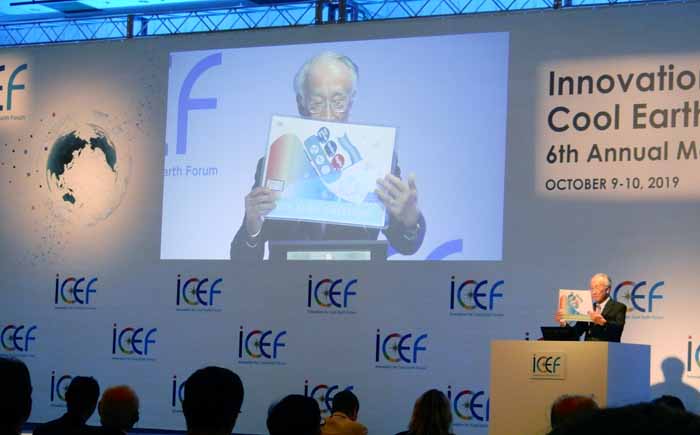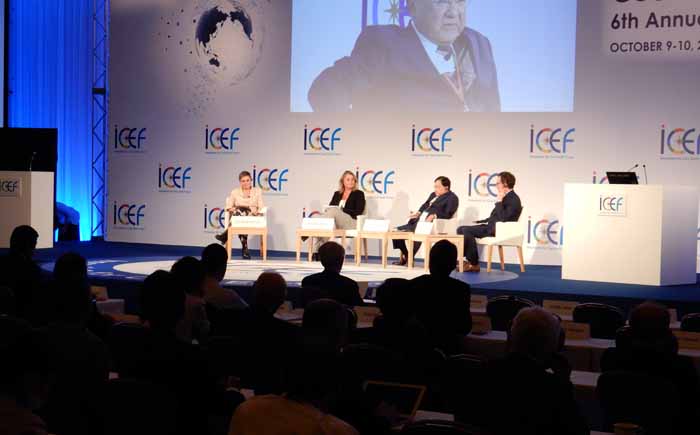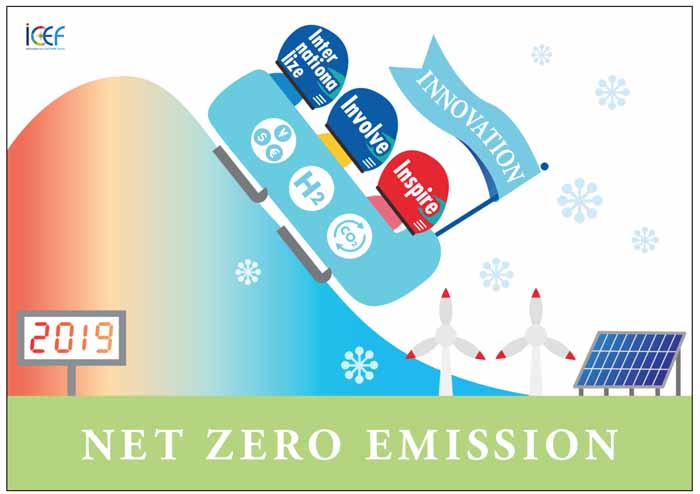
安倍総理の提唱に基づき、2014年から経済産業省と新エネルギー・産業技術総合開発機構(NEDO)の主催で開いてきた気候変動問題に関する国際会議「Innovation for Cool Earth Forum」(ICEF:アイセフ)が10月9日、10日の2日間、都内ホテルで開催され、世界70カ国・地域からエネルギー・環境分野の第一人者が一堂に会した。(佃モビリティ総研・間宮 潔)

閉会直前の本会議「産業の脱炭素化」で持続可能な企業経営にとって、ESG投資の重要性が強調された
日本主導の世界会議「ICEF2019」に世界から70カ国・地域が参加
同会議は、ICEF第6回年次総会として開催され参加者は1000人を超えた。学界や産業界、さらに政府関係者らハイレベルな有識者が脱炭素社会に向けて活発に議論、改めて最終目標の「ネット・ゼロ・エミッション」に向けたロードマップを示した。
とくに世界のCO2排出量が増加傾向にあることから「イノベーションとグリーン・ファイナンス」の重要性をステートメントの形で世界に発信、併せて坂を下るボブスレーを模したイラスト図を添付した。
開会式に臨んだ菅原一秀・経済産業大臣は、「気候変動問題の解決に向けたイノベーションへの、世界規模でのうねり、そして高い期待を改めて実感している。水素とカーボンリサイクルの導入に向けた新たなアクションを打ち上げました。
さらにG20の合意を受けて、世界トップクラスの研究機関からリーダーを集める国際会議、R20を開催、具体化させます。またイノベーションに取り組む企業の投資が集まる仕組みを構築するため、昨日、TCFDサミットを立ち上げました。イノベーションとファイナンスは車の両輪です。環境と成長の好循環の実現に向け、議論を深めていただきたい」と挨拶した。

ICEF 2019で発表されたインフォグラフィック
三つの本会議と三つの分科会を軸に、CO2排出ゼロをメーンテーマに議論
年次総会は大きく三つの本会議と、三つの分科会を軸にして、個別テーマが取り上げられ、サイドイベントも設けられた。
<本会議>としては、「産業・金融の脱炭素化イニシアチブ」(モデレーター:田中伸男氏=笹川平和財団会長)、「グリーン水素の国際ネットワーク」(モデレーター:サリー・ベンソン氏=スタンフォード大教授)、「産業の脱炭素化」(モデレーター:エイヤ-リイタ・コホーラ氏=元欧州議会メンバー)を開き、今開催のメーンテーマを議論した。
次いで<分科会>として、「再エネのグリッド接続」(座長:アジャイ・ㇲマール氏=インド・エネルギー資源研究所所長)、「分散電源のデジタル管理技術」(座長:山地憲治氏=地球環境産業技術機構副理事長)、「燃料電池」(座長:ジョーグ・エルドマン氏=ベルリン工科大学・退官教授)――など具体的なテーマに踏み込んだ。
また「原子力・核融合」「二酸化炭素を削減する遺伝子工学」「電動車両を活用したシェアリングサービス・商業利用」、「都市化と省エネ普及」「AI・ITを利用したエネルギーの効率利用」などの個別テーマで情報交換を図った。
基幹産業の脱炭素化を訴え、エネルギーからモビリティまでの先進的研究を選出
加えて年次総会を彩るサイドイベントとして、恒例となっている「トップ10イノベーション」が閉会時に発表となった。2050年までの長期の取り組みとして期待がもたれるカテゴリーA(R&D)では4事例を、また2030年までの中期の取り組みとしてカテゴリーB(社会実装)の6事例を選出した。
そうした数々の事例のなかで、二酸化炭素を吸収する新しい無機化合物を確認したカナダ・アルバータ大学などの研究グループ、CO2と水素からメタノールを製造する新たな酸化インジウム触媒を開発したスイスのETHチューリッヒなど先進的研究が紹介された。
カテゴリーBでは、沖縄・石垣島で始まった電動スクーターのシェリングサービス(℮₋SHRE石垣)が選ばれた。6秒程度で充電済みバッテリーが交換でき、充電ステーションでは災害時に備えて太陽光パネルと日産リーフ搭載のリサイクルバッテリーを設置している。
さらに水素発生装置で20年近い納入実績をもつ日立造船が今回、40フィートコンテナに初めて大型の固体高分子型水素発生装置を組み込み、再生可能エネルギー導入拡大に期待が込められた。屋外仕様で新たに建屋を作る必要がない。
気候変動に立ち向かうグリーン・ファイナンスの新たな活発な動きを紹介
このほか外国勢で「持続可能なジェット燃料」「電力を火山岩に熱として蓄積する技術」などが先進事例も選出された。閉会にあたり、ICEF運営委員会を代表して田中伸男委員長が挨拶、「イノベーションとグリーン・ファイナンス」のスローガンを掲げた意味合いを改めて強調した。
「CO2排出カーブを押し下げる目標を示したが、その目的の一つは警告である。CO2排出を減らすことがまだ始められていない、管理できていないということ。もう一つの認識はいま気候変動に立ち向かおうとグリーン・ファイナンスが先頭にたち、新たな活発な動きがみられている。
最初の本会議ではTCFDという新しいファイナンスの仕組み、これは単に企業のCO2排出量だけでなく、自らの戦略がはらむリスクも開示することが行われ、いまや199の日本の企業・組織がTCFDに調印した。ESG(環境・社会・ガバメント)投資は主流となっている。ビジネスはいまや気候変動に関して何も起こらないというフリを続けることはできない」と訴えた。
次いでデービッド・サンダロー委員(コロンビア大学世界エネルギー政策センター創立フェロー)が今回新たに追加した産業用途での脱炭素化のロードマップについて言及した。とくにセメント、鉄鋼、ガラス製造で利用されているボイラー、炉の脱炭素化は設備寿命から転換が難しく、水素や電化、バイオマス、バイオフューエルの四つのテクノロジー・オプションがある中で、〝グリーン水素”のみがゼロ・エミッションになるとし、政府の調達ルールを変更し、脱炭素を配慮することの重要性を訴えた。

ICEF2019会合の成果を語る田中運営委員長。ステートメントの内容を表現したインフォグラフィックを示した
ステートメントではCO2排出の軌跡(曲線)を下向きにする三つのキーアクションを提言
また山地憲治委員がステートメントを披露した。締め括りの「CO2排出の軌跡(曲線)を下向きにする戦略」について、「ネット・ゼロ・エミッションを実現することは非常に難しいが道筋をつけることが重要である」として三つのキーアクションを盛り込んだ。
「グリーンな成長のためのテクノロジー、製品・サービスに対する投資を鼓舞すること」「脱炭素に向けた技術革新を加速させるため、産業や消費者を巻き込むこと」「イノベーション成果を国際的に展開するため、国際協力に努めること」を示した。加えてCO2削減を加速させるため、低炭素優遇措置などの緊急支援策を求めた。
最後に主催者を代表してNEDOの石塚博昭理事長が挨拶。今回から外務省、環境省に加えて文部科学省が共催者に入るなど関係者の協力に感謝するとともに、政府機関の環境問題に関する各種会合、会議体との連携を呼びかけた。なお第7回ICEFを2020年10月7~8日に開催することを正式に発表した。
ICEFに係る英文ステートメントは以下の通り
ICEF 2019 Statement from the Steering Committee
October 10th, 2019
1. Preamble
The sixth annual meeting of the Innovation for Cool Earth Forum (ICEF 2019) was held in Tokyo on October 9 and 10, with more than 1,000 participants from government institutions, international organizations, industry, and academia, from approximately 70 countries and regions. The theme of this year’s forum was “Bending down the emissions trajectory by Innovation and Green Finance.”
Global CO2 emissions are increasing at about 2% per year, which is in line with the long-term historical trends since the beginning of the industrial revolution. We affirm our goal of achieving net-zero CO2 emissions, meaning that immediate peak and vigorous decline of CO2 emission is necessary. Since the gap between current trends and our goal is still getting worse, we have to re-emphasize the necessity of innovation in deployment as well as R&D, which are the key to narrow the gap. Additional policy measures such as fiscal incentives and new technologies that could reduce emissions at scale must be deployed on an urgent basis.
ICEF’s mission is to facilitate discussion and encourage cooperation among participants with a view to promoting technological and social innovation in the field of energy and environment.
The following statement summarizes how the world will accelerate actions that should be taken with high priority.
2. Importance of ESG investing and a virtuous cycle of environment and growth
At the G20 Ministerial Meeting on Energy Transitions and Global Environment for Sustainable Growth held in June, ministers realize the importance of a virtuous cycle of environment and growth that is strongly supported by innovations, mobilization of finance including investment, and improvement of the business environment.
According to G20 Ministerial meeting’s communiqué, the G20 Energy Ministers will step up existing international efforts to unlock the potential of hydrogen as a clean, reliable and secure source of energy including cooperation in research and development, evaluating hydrogen’s technical and economic potential, cost reduction pathways and addressing the various challenges including regulations and standards.
Fundamental decarbonization of industrial activities is one of the major challenges to realize net-zero CO2 emissions. New approaches such as CCUS, hydrogen-based direct reduced iron, carbon recycling and zero-emission cement are inevitable.
While recognizing that public finance and gender lens investing plays an important role, we call upon all players to support efforts to mobilize private finance and increase transparency through more enhanced climate-related financial disclosure based on the TCFD’s recommendation with effective communication between business and financial sectors, as well as to improve the market and investment environment.
During ICEF 2019, these topics were taken up in the three plenary sessions. In addition, twelve different approaches to accelerating innovation—six in the social context and six in the technological context—were chosen and discussed in depth in concurrent sessions. Conclusions are as follows:
3. Acceleration of activities toward realization of Social Innovation
– For promotion of larger scale deployment of carbon dioxide removal technologies, social understanding and awareness as well as the clarification of the magnitude of emission reduction are indispensable.
– Involvement of businesses as well as customers in accelerating technologies and innovation is of great importance. Enhancing the efficacy of climate communications could contribute widely.
– Electrification of the transport sector requires enhancement of electricity infrastructure, including massive expansion of EV charging systems.
– Scaling up renewable energy use and extensive introduction of Zero Energy Buildings could contribute to coping with growing energy demand and to easing environmental damages, such as air pollution resulting from rapid urbanization.
– Demand-side driven transformation has been happening; and digitalization utilizing AI and IT devices as core technology can contribute to the realization of a low energy demand scenario.
– Evaluation of benefits and impacts of plastics at each phase of use, such as value of plastics use for durable products and contribution to food preservation, is necessary to substantially protect the marine and land ecosystem, as well as could contribute to the development of alternatives for plastics.
4. Acceleration of activities toward the realization of Technology Innovation
< Innovations in deployment stage >
– Deployment of existing renewable technologies such as solar, wind and storage should be accelerated. Advancing grid technologies and acknowledging economic value of system stabilization can contribute to the efficient use of renewable energy. Microgrid technology utilizing renewable energy and network technologies can play an important role in improving grid resilience.
– Expanding the use of fuel cells, setting standards for element technologies, as well as the standardization and modularization of total systems are major concern.
– Wider application of digital technology on both the supply and demand side of electricity and heat such as remote control and unmanned operation, enables efficient use of distributed power sources.
< Innovations in R&D stage >
– Small modular and nuclear fusion reactors are currently under development by various actors, including venture businesses. Policy and R&D strategy from a longer-term perspective will effectively guide actors, especially venture businesses, in their endeavors.
– The rapid advancement of genome technologies shows huge potential in contributing to CO2 emission reductions, but such technologies need to be treated carefully from an ethical perspective to avoid negative implications.
– In order to promote research and development in the field of CO2 utilization, comprehensive assessment of life-cycle CO2 emission/absorption is recommended.
5. Strategies for bending down the emissions trajectory
Achieving and deploying innovation requires the engagement of all industrial sectors, academia, governmental institutes, financial institutions, and investors in promoting research, development, investment, and business creation. Although “Bending down the emissions trajectory” itself is difficult to realize at this immediate moment, the short-term target should be attained within a few years to pave the way towards the long-term goal of net-zero emissions. We call upon all players to join forces in further cooperation and collaboration, and to carry out with unprecedented urgency the “Three Key Actions” identified at ICEF 2018: 1) inspire investment in technology, products, and services for green growth; 2) involve industry and consumers in accelerating technologies and innovation for decarbonization; and 3) internationalize cooperative efforts for deploying innovation outcomes. In addition, we call for urgent policy support for accelerated emission reduction from carbon-intensive facilities.
